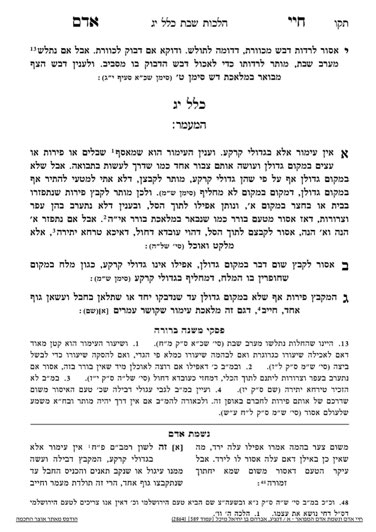Sponsorships for the upcoming Klalim, which discuss the 39 melachos of Shabbos, are available. Please contact Rabbi Reingold for more information at rabbireingold@gmail.com or 301.996.5910
We are beginning Klal 14, which discusses the melacha of dosh. Dosh is threshing, the process of breaking the kernel of wheat away from the husk which held it to the stalk. Additionally, it includes breaking the kernel out of its husk. Once this process is completed, a person has the kernels available to mill into flour. The shiur chiyuv for the melacha of dosh is to thresh a grogeres worth of grain. This necessarily means that one started out with more than a groceries of stalks, and then threshed them to produce a grogeres worth of grain.
Nevertheless, any amount is still assur mideoraysa, due to the concept of chatzi shiur assur min hatorah. This is the concept that, for example, it is still assur to eat even the most minimal amount of non-kosher food, even though one would only receive makos for eating a kezayis. There is a machlokes in the Gemara regarding chatzi shiur, but we pasken that it is an issur deoraysa.
Regarding Shabbos, there is an opinion that the concept of chatzi shiur only applies to food and not to actions, and therefore dosh on less than a grogeres would not be assur mideoraysa. However, the Chayei Adam concludes that this concept applies to the melachos of Shabbos as well.
The Chayei Adam continues, and writes that dosh only applies to gidulei karka, items which grow from the ground.
Next, the Chayei Adam tries to define the melacha of dosh. We know that in the mishkan, dosh was performed in a specific way, and the question will be how close must a person’s action be to the action performed in the mishkan to be chayav mideoraysa. Part of the question is understanding the difference between dosh and borer. Both require separating good from the bad by separating the kernel from the husk and the straw.
There is a machlokes in the achronim regarding the latter question. One explanation is that dosh refers to situations where the items were previously attached before they were separated, while borer refers to a mixture of items which are not attached to each other. Over here, the kernels are attached to the wheat stalks, and dosh is breaking them apart. Once the stalks and grains have been broken apart, usually they remain in a mixture. Borer refers to the process of separating between them in the remaining mixture. Thus, the severing of the stalk from the kernel is dosh, and the separating afterwards is borer.
The problem with the above explanation is that practically, we apply dosh to items which are not attached, so we will need to revisit this definition
The Chayei Adam writes that it is known that the melacha of dosh is the process of breaking apart the food or kernel from its stalk or pod. The Chayei Adam specifically uses the words nivlah bo to describe this point, and we will discuss it further tomorrow.
Summary
Dosh refers to the melacha of threshing, which is to separate stalks from their kernels.
The shiur chiyuv is a grogeres of kernels, but anything less is assur as a chatzi shiur.
It only applies to gidulei karka
Dosh is different from borrer, because dosh assumes that the items are attached, and borrer is a mixture which is not necessarily attached.



